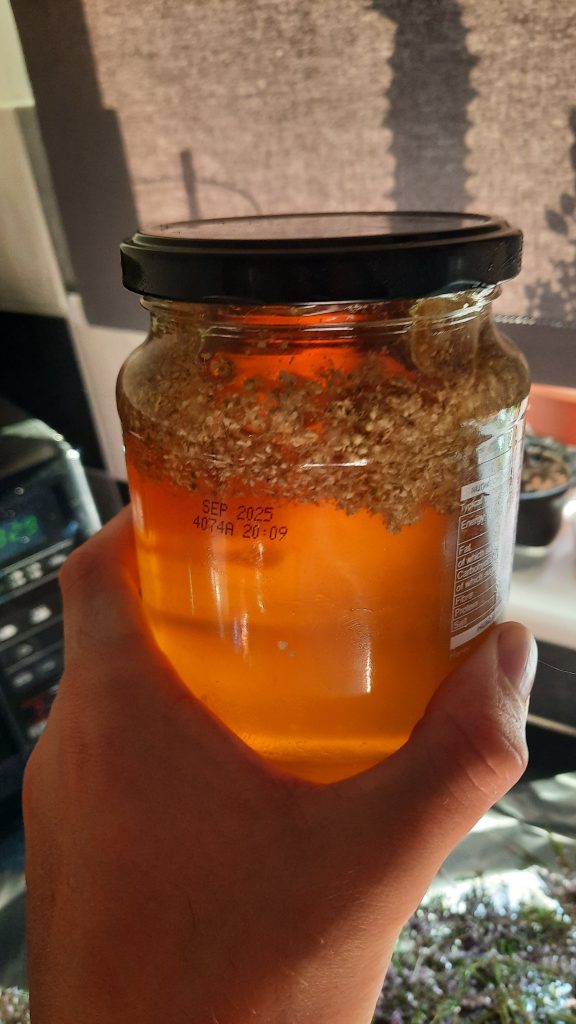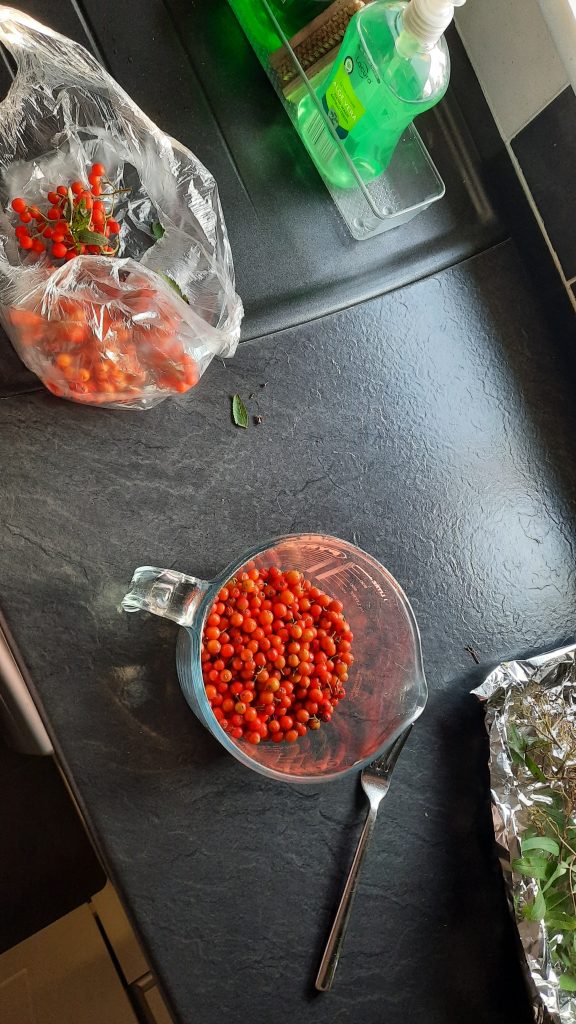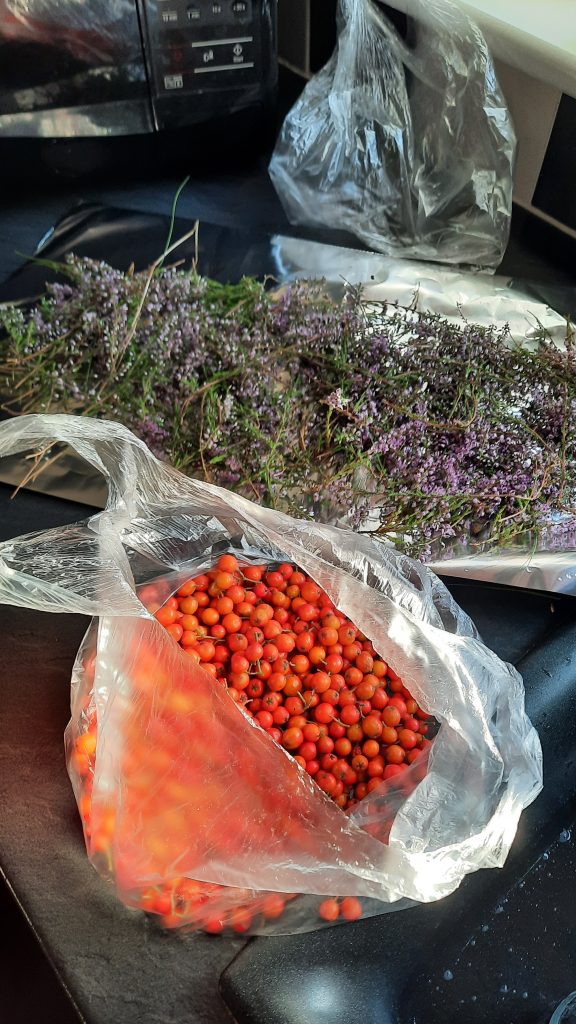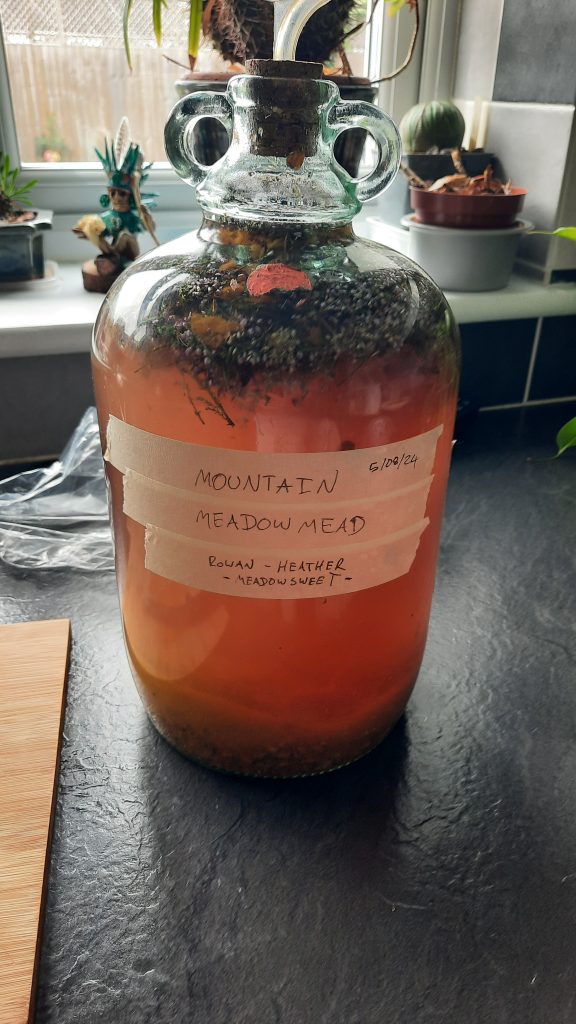
Brew Mead Like a Mountain Man: How to Make a Pictish Wildflower Mead
In this recipe, you will learn how to make “Pictish mead”, a brew based on ancient highlands folklore and quite a lot of guesswork. All the ingredients can be found on a singular stroll in your favourite mountainous area. The Brecon Beacons, the Peak District and the Scottish Highlands are all excellent places to find what we need.
This recipe was originally written for Totally Wild UK.
This mead was brewed out of convenience, as on my summer walk I found Meadowsweet, Heather and Mountain Ash in abundance. What I failed to realise, and only discovered later, was that I was following in the footsteps of a mysterious and ancient people called the Picts, who inhabited parts of Scotland, Wales and Ireland and could be seen as precursors to the Celts.

A PICTure (See what I did there?)
By Iantresman at en.wikipedia – Source: William Howitt, John Cassell, John Cassell’s Illustrated History of England: From the earliest period to the reign of Edward the Fourth., Editor: John Frederick Smith, Publisher W. Kent and Co., 1857. Page 6
The Picts inhabited ancient Britain around 600 AD onwards, living alongside Anglo-Saxon and Gaelic neighbours. Some archaeological evidence has led people to theorise that the Picts were a race of people often short in stature, but opinions differ on this. Some have attributed the “Pygmy-Pict” phenotype as the inspiration for dwarves in British folklore, a people hailing from mountainous areas evoking images of J.R. Tolkien’s dwarven strongholds in Lord of the Rings.
The Picts are said to have been masters of brewing, and had a recipe for a renowned drink sometimes referred to as Heather ale, and sometimes as Heather mead. Given the absence of reliable and pure sugar sources in 700 AD, it is most likely that the Picts brewed using fermented honey, corroborating the idea that this legendary ale was indeed a honey wine, or mead. The heather component of their honey comes with a simple explanation: Picts were mainly farmers living in highland areas, if they practiced beekeeping and kept Apiaries, these bees would have feasted on the most common flower present in the highlands, Heather!
To anyone who has experienced the joy of true Heather honey, it is unlike almost any other variety. It forms a jelly-like substance that becomes more liquid when stirred, and contains a much higher protein content than standard mixed-flower honey. When fermented, this protein content actually increases. Some say that Heather honey is almost a complete food by itself, making a fermented beverage containing the honey akin to a primitive protein shake. This would have been an extremely beneficial health drink to those living in such harsh highland environments.
The recipe for the Pict’s mead is unfortunately lost to time, a poem by Robert Louis Stevenson tells the story of the last Pictish King and his son, the last of their kind after being subject to extermination by the Scots. They decided to leap into the ocean instead of giving up the recipe to their sacred drink. Today we can only speculate on the potential ingredients and brewing process.

Locating Heather up a mountain – Evidence of dwarven activity in the hewn rockface
On my walk in the Welsh mountains, I did not raid a beehive and return with a jar of fresh honey, however I did pick some heather flowers. Although the complete recipe for Pictish mead has been lost to time, one of the known ingredients was fresh heather tops, growing in abundance and feeding the Pict’s beehives. Heather flowers give a wonderful floral taste to anything they are steeped in (tea, alcohol etc.) so into the basket they went.
NOTE ON RESPONSIBLE FORAGING: Please do not go to your nearest mountain and rip up clods of heather, and definitely don’t pick from just one patch. Check to ensure the area you are picking from is not under special protection, if it is not, then pick as you walk. A little handful here and there will quickly add up to enough. I picked enough heather to fill a cupped handful and no more. We want to make it seem as though we were never there and leave as many flowers for the birds and bees as possible. If you really like Heather, I would encourage you to buy some plants from a local garden centre and add them to a well-drained spot in your garden.
Heather is apparently full of antioxidants and can be a useful anti-inflammatory, however here it was mainly used for flavour. The recipe I devised did not contain Heather honey, as I was ignorant at the time of the existence of the Pictish recipe. The reason I have drawn upon the Picts in the article is that I was walking their native landscape and picking plants that would have been readily available to them at the time of harvesting their Heather honey. It is likely that the extra plants I found would have also been included in fermentations to add flavour and extra nutrition, but this is all fun speculation! If you can afford to brew with Heather honey, I greatly encourage you to follow this recipe and include this also for added flavour and nutrients. In reality, the Picts likely used numerous other parts of the beehive in their recipe too.
The next flower I encountered was Meadowsweet, usually growing at lower levels on the way up the mountain paths. You will likely encounter meadowsweet first, then heather as you gain elevation.
Meadowsweet is a fantastic smelling plant, very sweet, very floral (as the name would suggest). The flower contains Salicylic acid, a painkilling compound most commonly found in aspirin, in small quantities, Meadowsweet can be used in your concoctions without ill effect, but please note, too much of the flower can cause adverse effects. I used a large handful of the flowers, removed from their stems, as flavour for 1 gallon of mead. Its inclusion was twofold, one as flavour to compliment the Heather, but also for its mild painkilling and anti-inflammatory qualities. It is highly unlikely that its uses escaped the knowledge of the Picts or other tribes that lived in these areas, horses are known to regularly eat it if they encounter discomfort. Into the basket they went.
Please note, Meadowsweet apparently doesn’t dry very well and loses its beneficial properties quite quickly. Please read on to see how I preserved it for use.

Meadowsweet flowers preserved in honey
Finally, I braved the Mountain Ash AKA the Rowan tree. A distinctive tree with light-coloured bark, fine leaves and alluring red/orange berries, once you are able to ID a Mountain Ash, you are likely to see them everywhere. They prefer mountainous areas but will grow almost anywhere in the UK, I have seen them by standard roadsides. The strange thing about Mountain Ash is that despite bearing a great quantity of berries, nothing seems to eat them! In contrast, you have to fight tooth and beak with pigeons, squirrels and other forest friends during Elderberry season. The Mountain Ash is nowhere near as popular.
This applies for humans too, I know of few recipes that employ Mountain Ash berries outside of james and conserves. These berries need to be cooked before consumption just like Elder, but done correctly, will contain a useful source of Vitamin C. There are other rumored uses of Mountain Ash berries in traditional herbalism, but none substantial enough to report here. My theory stands, the berries grow at the same time as Heather and Meadowsweet, surely they would have been used for something out of necessity? I have heard there is a lost recipe for a Welsh wine containing these berries, could there be a link between the lost Pictish recipe and this wine? I cannot give an answer, but they will add some good flavour to our mead, extra vitamins and a beautiful deep-red colour.

Mountain Ash berries ready for freezing
As I walked, I gathered a large double handful of the Ash berries, ensuring I picked the ones of the deepest red colour for the best ripeness. I say again, DO NOT EAT THESE RAW. They can cause vomiting and gastric upset if you have too many, they’ll go in the cooking pot to render them safe.
RECIPE
If you encountered my previously published recipe on Totally Wild UK, detailing how to make a winter Elderberry mead, you will know that I use very low-fuss, primitive brewing techniques. The same applies here. I used the wild yeast present on the Heather flowers for this recipe, so didn’t add any packet yeast.
I measure a lot of things by hand or eye. This entire process was experimental, you don’t need to follow it to the letter. Just know the foundational elements of how to ferment, have fun and don’t be afraid to make mistakes!
A note on honey, as mentioned in my previous article, please use single-source honey where you can. If you pick up a jar that says “a mix of EU and non-EU honeys”, don’t buy it. A recent study was done that shows most of this stuff is adulterated sugar syrup imported from China.
Local honey is the best to use, but it is expensive for the quantity needed. The next best step is to locate something labelled “Polish wildflower honey”, or “Greek heather honey” and so on. These should be traceable to a single country, pure, and will have an exciting array of flavours that will differ from the fake stuff.
Ingredients:
1200g Honey (Use heather honey if you can afford it)
Double handful of Heather flower tops
Handful of Meadowsweet
Double handful of Mountain Ash berries
1 Gallon water
Equipment:
For a gallon of mead you will need:
- 2 Demijohns or fermentation vessels
- 1 airlock
- 1 rubber tubing or siphon
- A gallon cooking pot
- A wooden spoon for mixing
- Enough bottles for a gallon of liquid (usually works out around 5 or 6 wine bottles)
- 1 gallon of water
- Measuring jug
- Optional: potato masher

Heather flowers and Mountain Ash berries
- Preserve your ingredients
Meadowsweet especially degrades very quickly. I found the best way to preserve it is to combine it with your Heather flowers and stir the entire lot into a jar of honey. The honey will halt any microbial action and will keep the flowers in an almost fresh state. This has the added benefit of infusing the honey with your floral mix. This by itself is technically a medicinal honey, and can be added to warm water and drunk as a painkilling/anti inflammatory tea.
Freeze your Mountain Ash berries. This will make the end result sweeter, as the freezing will burst the cell walls of the berries and release more sugar. This will also preserve the Vitamin C content. - I am now beyond the stage of bothering to sterilise my equipment unless there is mould around, or I’ve just bought new equipment to use.
If your demijohns have yeast residue from a previous ferment, good news, that brown layer may contain dormant yeast, which can become active again in the presence of moisture, warmth and sugar. Some cultures would purposefully carve channels into the walls of their fermentation vessels to allow yeast to settle and go dormant, to be reactivated next time they were due to brew.
If you are more particular than me, then by all means sterilise your equipment with a campden tablet or a small amount of bleach. - Bring your gallon of water to the boil, then allow it to cool. In the case of using tap water, this will help evaporate some of the chorine present, reducing the chances that it will harm your yeast.
Reduce the heat to just below a simmer, then add your Mountain Ash berries. Simmer at approx 65 C for another 10 minutes. Use a potato masher or wooden spoon to squash the berries and extract the most juice. - Allow the mixture to cool until it is just warm to the touch, 40 C or below. Add your 1200g of Meadowsweet/Heather honey to the mix, stirring until it is dissolved. We do this at a lower temp to preserve the more delicate components in the honey from destruction by heat.
The flowers you preserved should be coated in dormant wild yeast. This is what the Picts would have used to create a fermented drink of around 5% alcohol. If you want a stronger brew, add packet yeast at this stage. - Pour the mixture into the demijohn with the aid of your measuring jug. This is a messy process. Most guides recommend passing the mixture through a filter to remove the berry husks before fermentation, however I left mine in to provide more food for the yeast.
- Seal the demijohn with the airlock, wait for the demijohn to cool to around body temperature. Take the airlock off, add your yeast solution, and re-seal. Your vessel is ready, let the sacred ferment begin!
- Leave your demijohn in a warm, dark place. In Norwegian folklore, it was said that the spirit of the bryggjemann (what we now know is yeast) will enter the jar at night and make it boil. By the morning, you should see bubbles appearing in your vessel. If this doesn’t happen, don’t panic! Fermentation can take up to a week to start.
Once your liquid is “boiling”, the bryggjemann has paid your jar a visit, and your liquid is now alive with his spirit! (The anaerobic respiration of yeast). The wild yeast might take up to a week to start fermenting your mixture, so hang in there!
- WAIT. Because of the complex sugars present in honey, fermenting mead takes longer than a normal beer or wine. You can expect the bubbling to stop in about 3 weeks.
- Syphon (or rack) your mead using a piece of rubber tubing, into your secondary Demijohn. There will be sediment, berry husks etc. at the bottom of your vessel, syphon down to this layer and discard the rest of the debris.
- Leave your brew in the demijohn for at least 3 months before bottling, or you risk incomplete fermentation, and might create some exploding bottles! I am planning to leave this brew in a demijohn for around 10 months to allow it to clarify somewhat before bottling.
Syphon the mead from your secondary ferment into your bottles with the rubber tubing.
Your mead in this case will be mildly carbonated, as we won’t be ageing it long enough to clarify and rid itself entirely of CO2.
If you wish to save your yeast for use again, leave the top off the brewing vessel and simply allow the dregs at the bottom of the demijohn to dry. Your own household bryggjemann is now sleeping and ready to be woken up again next time you brew.

Ready to ferment – whole flowers included to encourage wild yeast colonisation
And there we have it. After a walk, a forage and months of waiting, you will have a beverage worthy of the Pictish folk stories. I have not yet sampled mine, as it has only aged 6 months and I’m waiting for the full flavour to develop at around the 10 month mark. I expect it to be delicious, but results may vary. If it ends up being disgusting for whatever reason I will come back and heavily edit this article…
I haven’t provided sources for the information in this article, but most of it can be attributed to Stephen H. Buhner, of whose writing I am a big fan. Sacred and Herbal Healing Beers is a wonderful book that you should read if any of the esoteric brewing knowledge in this article is of interest.
8 MONTH EDIT: This is definitely a lower alcohol mead with a gentle flavour, the Rowan berries have left a slight pectin haze, but it looks attractive now it’s been bottled. I will wait a full year before drinking, the flavour is there, albeit still slightly yeasty.
